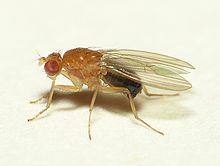The Drosophilidae are a diverse, cosmopolitan familyofflies, which includes species called fruit flies, although they are more accurately referred to as vinegar or pomace flies.[1] Another distantly related family of flies, Tephritidae, are true fruit flies because they are frugivorous, and include apple maggot flies and many pests. The best known species of the Drosophilidae is Drosophila melanogaster, within the genus Drosophila, also called the "fruit fly." Drosophila melanogaster is used extensively for studies concerning genetics, development, physiology, ecology and behaviour. Many fundamental biological mechanisms were discovered first in D. melanogaster.[2] The fruit fly is mostly composed of post-mitotic cells, has a very short lifespan, and shows gradual aging. As in other species, temperature influences the life history of the animal. Several genes have been identified that can be manipulated to extend the lifespan of these insects. Additionally, Drosophila subobscura, also within the genus Drosophila, has been reputed as a model organism for evolutionary-biological studies,[3] along with D. sechellia for the evolution of host specialization on the toxic noni fruit[4] and Scaptomyza flava for the evolution of herbivory and specialist on toxic mustard leaves.[5]
| Drosophilidae | |
|---|---|

| |
| Lordiphosa andalusiaca | |
| Scientific classification | |
| Domain: | Eukaryota |
| Kingdom: | Animalia |
| Phylum: | Arthropoda |
| Class: | Insecta |
| Order: | Diptera |
| Superfamily: | Ephydroidea |
| Family: | Drosophilidae Rondani, 1856 |
| Subfamily | |
Generally, drosophilids are considered to be nuisance flies rather than pests, since most species breed in rotting material. Zaprionus indianus is unusual among Drosophilidae species in being a serious, primary pest of at least one commercial fruit, figs in Brazil.[6] Another species, Drosophila suzukii, infests thin-skinned fruit such as raspberries and cherries and can be a serious agricultural pest.[7] The leaf mining Scaptomyza flava, which is nested in the genus Drosophila phylogenetically, is an obligate leaf miner of mustard plants, including the model plant Arabidopsis thaliana[5] and is a major pest of salad brassicas in New Zealand and an emerging pest of canola in the UK.[8] Drosophila repleta larvae inhabit drains and spread bacteria. Fruit flies in general are considered as a common vector in propagating acetic acid bacteria[9] in nature. This often ruins the alcohol fermentation process and can ruin beer or wine by turning it into vinegar. There are sinking traps available on the market for this nuisance, but one quick way to strongly limit the extent of it is to vacuum clean the flies both at rest and in their slow flight.
The diagnostic characteristics for Drosophilidae include the presence of an incomplete subcostal vein, two breaks in the costal vein, a small anal cell in the wing, convergent postocellar bristles; and usually three frontal bristles on each side of the head, one directed forward and the other two directed rearward. More extensive identification characteristics can be found in "Drosophila: A Guide to Species Identification and Use" by Therese A. Markow and Patrick O'Grady, (Academic Press, 2005) ISBN 0-12-473052-3 or "Drosophila: A Laboratory Handbook" by M. Ashburner, K. Golic, S. Hawley, (Cold Spring Harbor Laboratory Press, 2005).
There is evidence to support that pathogens living within certain flies are beneficial to the behavior and survival of the host. One such example of this is in the fly Scaptomyza flava, which carries the pathogen Pseudomonas syringae in exchange for the pathogen damaging the anti-herbivore defenses of main food source for the fly, plants in the family Brassicaceae.[10]
The family contains more than 4,000 species classified under 75 genera. Recently, a comprehensive phylogenetic classification of the genera based on both molecular and morphological characters has been published.[11]